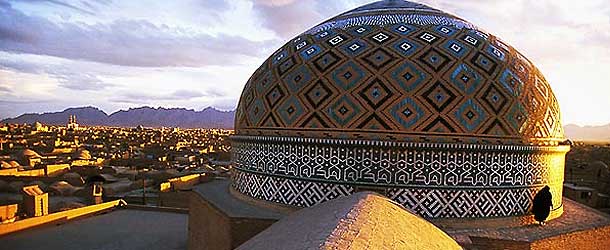IRAN

Iran is the eighteenth largest country in the world. Its area roughly equals that of the United Kingdom, France, Spain, and Germany combined, or slightly less than the state of Alaska. Its borders are with Azerbaijan (432 km/268 mi) and Armenia (35 km/22 mi) to the north-west; the Caspian Sea to the north; Turkmenistan (992 km/616 mi) to the north-east; Pakistan (909 km/565 mi) and Afghanistan (936 km/582 mi) to the east; Turkey (499 km/310 mi) and Iraq (1,458 km/906 mi) to the west; and finally the waters of the Persian Gulf and the Gulf of Oman to the south. Iran's area is 1,648,000 km² (approximately 636,300 sq mi). Iran's economy is a mixture of central planning, state ownership of oil and other large enterprises, village agriculture, and small-scale private trading and service ventures. Iran ranks second in the world in natural gas reserves and also second in oil reserves. It is OPEC's 2nd largest oil exporter. Greater Iran is home to one of the richest artistic traditions in world history and encompasses many disciplines, including architecture, painting, weaving, pottery, calligraphy, metalworking and stone masonry. The Culture of Iran is a mix of ancient pre-Islamic culture and Islamic culture. Iranian culture probably originated in Central Asia and the Andronovo culture is strongly suggested as the predecessor of Iranian culture ca. 2000 BC. Iranian culture has long been a predominant culture of the Middle East and Central Asia, with Persian considered the language of intellectuals during much of the 2nd millennium, and the language of religion and the populace before that. The Sassanid era was an important and influential historical period in Iran as Iranian culture influenced China, India and Roman civilization considerably, and so influenced as far as Western Europe and Africa. This influence played a prominent role in the formation of both Asiatic and European medieval art. This influence carried forward to the Islamic world. Official language of Iran is Persian. Next to Persian there are many publications and broadcastings in other relatively large languages of Iran such as Azeri, Kurdish and even in relatively smaller ones such as Arabic and Armenian. Many languages have originated from Iran, but Persian is the most used language. Persian is a tongue belonging to the Aryan or Indo-Iranian branch of the Indo-European family of languages.
Tehran

Tehran is the capital and largest city of Iran, and the administrative center of Tehran Province. Tehran is a sprawling city at the foot of the Alborz mountain range (the highest point in the Middle East (1,191 m, 3,900 ft)) with an immense network of highways unparalleled in Western Asia. Tehran is famous for its numerous ski resorts on the Alborz slopes, large museums, art centers, and palace complexes. Tehran is the largest city in the Middle East and is the most populated city in South Western Asia with a population of 7,404,515 and approximately 15 million in Greater Tehran. Most Iranian industries are headquartered in Tehran. The industries include the manufacturing of automobiles, electrical equipment, military weaponry, textiles, sugar, cement, and chemical products. It is also a leading center for the sale of carpets and furniture. There is also an oil refinery located in south of the city. Tehran is a relatively old city; as such, it has an architectural tradition unique to itself. Archaeological investigations and excavations in Tehran demonstrate that this area was home to civilizations as far back as 6,000 years BC. Tehran, as Iran's showcase and historical capital city, has a wealth of cultural attractions. The Peacock Throne of the Persian Kings (Shahs) can be found in Tehran's Golestan Palace. Some of the well-known museums are National Museum of Iran, Sa'dabad Palaces Complex, Glassware and Ceramics Museum of Iran, The Carpet Museum of Iran, Tehran's Underglass painting Museum, and Niavaran Palace Complex. The Tehran Museum of Contemporary Art features the works of great artists such as Van Gogh, Pablo Picasso and Andy Warhol.




